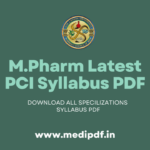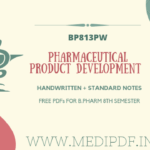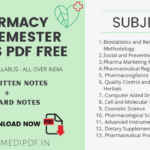Hi guys, in this post, I have provided an overview and PDFs of notes on the subject Modern Pharmaceutical Analytical Techniques. Read the overview below, and by clicking on the download button, you can easily download the PDFs of these notes.
These notes are designed according to the PCI syllabus for M.Pharmacy (Master of Pharmacy) students in India, so all M.Pharmacy students in India can make use of them.
Modern Pharmaceutical Analytical Techniques is a subject that is common to all specializations in the M.Pharmacy course in India, except for Regulatory Affairs and Pharmacy Practice, in the 1st semester.
Overview:
Modern Pharmaceutical Analytical Techniques notes are written in simple language, providing a concise overview of advanced analytical instrumental techniques used in the identification, characterization, and quantification of drugs. The focus is on several key instruments, including NMR (Nuclear Magnetic Resonance), Mass Spectrometry, IR (Infrared Spectroscopy), HPLC (High-Performance Liquid Chromatography), and GC (Gas Chromatography).
The objectives of these notes are twofold. Firstly, students will gain knowledge about Chemicals and Excipients, which are important components of pharmaceutical formulations. Secondly, they will develop the necessary skills to analyze various drugs in both single and combination dosage forms.
The notes aim to equip students with both theoretical and practical proficiency in utilizing these analytical instruments. By the end of the notes, students will have a solid understanding of the principles behind the instruments and will be capable of effectively employing them for drug analysis.
Download Modern Pharmaceutical Analytical Techniques Notes PDF
1) UV-Visible spectroscopy:
2) IR spectroscopy:
3) Spectrofluorimetric:
4) Flame emission spectroscopy and atomic absorption spectroscopy:
5) NMR spectroscopy:
6) Mass Spectroscopy:
7) Chromatography:
- Paper chromatography
- Thin Layer chromatography
- Ion exchange chromatography
- Column chromatography
- Gas chromatography
- High-Performance Liquid chromatography
- Affinity chromatography
8) Electrophoresis:
- Paper electrophoresis
- Gel electrophoresis
- Capillary electrophoresis
- Zone electrophoresis
- Moving boundary electrophoresis
- Isoelectric focusing
![Modern Pharmaceutical Analytical Techniques Notes [FREE PDF] 1 Modern Pharmaceutical Analytical Techniques Notes PDF](https://medipdf.in/wp-content/uploads/2023/06/Modern-Pharmaceutical-Analytical-Techniques-notes.png)





Iam not able to download pdf here so please help ne
We updated the download link, check now.
Plz sir plz provide
Life saver..May God bless you 💓
I want m.pharma nots 1sem
We will update you after updating all the notes. Stay tuned with us and follow our WhatsApp group/Telegram channel to receive notifications about updates.
Thank you for your valuable feedback ❤️
Kindly give M.pharm notes in pharmacology
Sir I’m not able to download the notes of modern analytical techniques plss help me
Check now…
Bro can’t download the modern pharmaceutical analytical notes
I want Modern pharmaceutical analysis notes
Give M. Pharm pharmacognosy notes
Hi I want notes
Which notes you want, specify correctly?